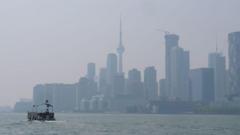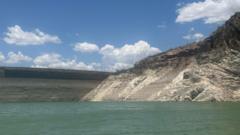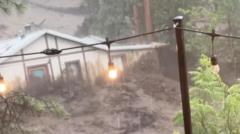Wildfires in Los Angeles County demonstrated significant increases in toxic chemicals in the air, including lead and chlorine, raising concerns about long-term health effects and the dangers posed by urban fires incorporating materials from homes and vehicles.
Toxic Consequences of L.A. Wildfires Exposed by New Air Quality Monitoring

Toxic Consequences of L.A. Wildfires Exposed by New Air Quality Monitoring
Researchers reveal alarming spikes in airborne toxins during recent Los Angeles wildfires, highlighting the health risks of urban wildfires fueled by residential structures.
As wildfires ravaged Los Angeles County, researchers documented a disturbing rise in airborne toxins, revealing that the atmospheric concentration of lead—a known neurotoxin—skyrocketed to 100 times above average levels, even several miles from the flames. Concurrently, chlorine levels surged to 40 times the norm. These findings signal the profound risks associated with urban wildfires, as burning materials in homes and infrastructures release harmful chemicals into the environment.
According to early instrumentation reports revealed by The New York Times, the unprecedented levels of lead and chlorine detected were in areas such as Pico Rivera, about 11 miles south of the Eaton Fire. Researchers argued that this event underscored a new phase in wildfire effects, with implications that extend beyond natural vegetation to include the toxic smoke resulting from the burning of urban structures.
Ph.D. candidate Haroula Baliaka of the California Institute of Technology emphasized that wildfires have transformed dramatically; they are not limited to forests anymore. “They are urban wildfires, fueled by the very materials that make up our homes and cities,” she remarked. As climate change progresses, alongside increasing urban development, the likelihood of such hazardous wildfires is poised to intensify, generating considerable concern for public health.
The implications of the toxic smoke are serious, as the damage from inhaling lead is particularly pronounced for vulnerable groups, such as children. The levels observed during this wildfire event exceeded Environmental Protection Agency safety limits by more than threefold. Inhalation of chlorine can lead to respiratory damage, underscoring the critical need for awareness around the dangers posed by smoke pollution from urban fires.
Research in recent years weaponized the link between wildfire air pollution and health risks, with previous studies suggesting that wildfire smoke was linked to up to 12,000 premature deaths in California in 2018 alone. Particularly alarming is how wildfire smoke undermines progress made in reducing air pollution elsewhere, as climate change exacerbates the frequency and scale of these disasters.
The data collected during these fires was part of the federally funded ASCENT network, established to assess air quality and pollution in real time. Notably, atmospheric scientist Nga Lee Ng points out that the urban setting of these wildfires results in smoke that contains a more insidious variety of toxic particles, compounding their public health risks.
The experience from the Los Angeles wildfires serves as a clarion call, emphasizing the urgent need for enhanced air quality monitoring and a reevaluation of urban planning strategies to mitigate future fire disasters and safeguard public health.



















